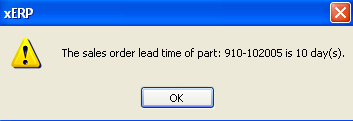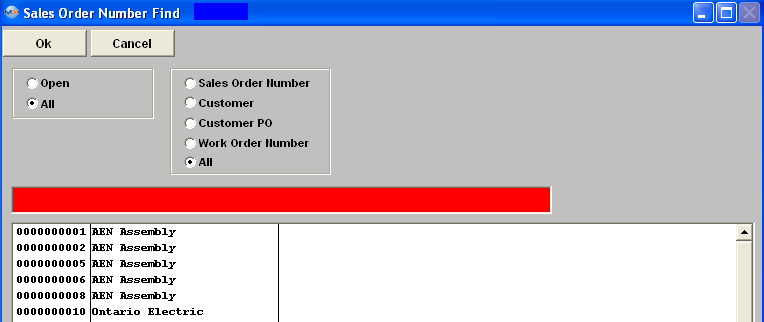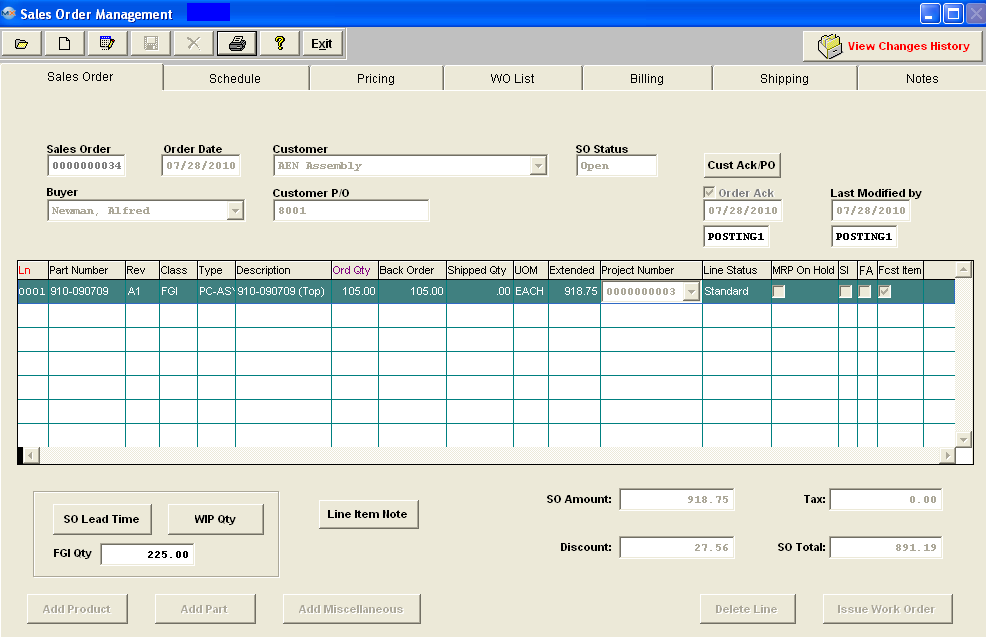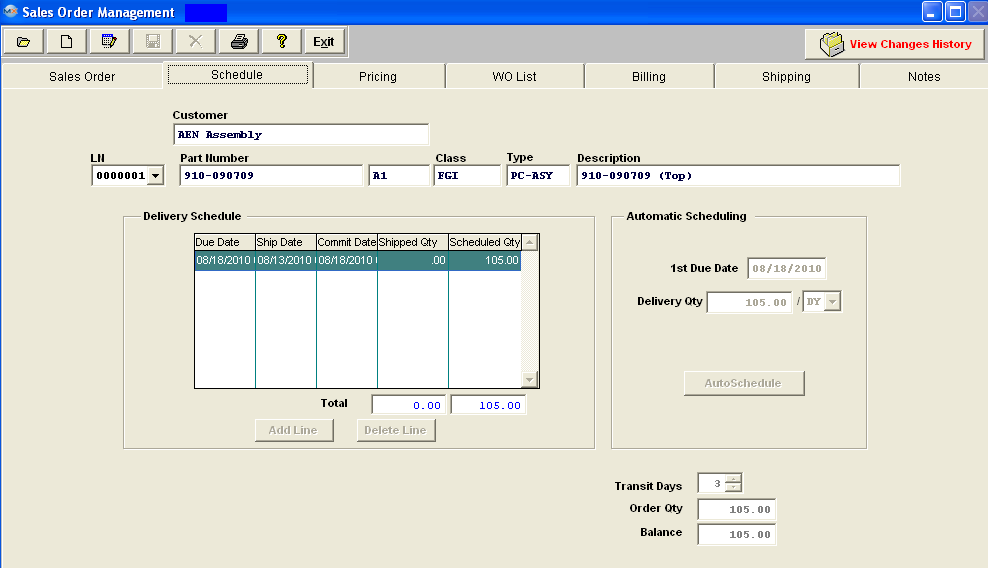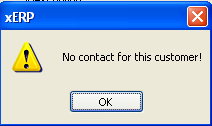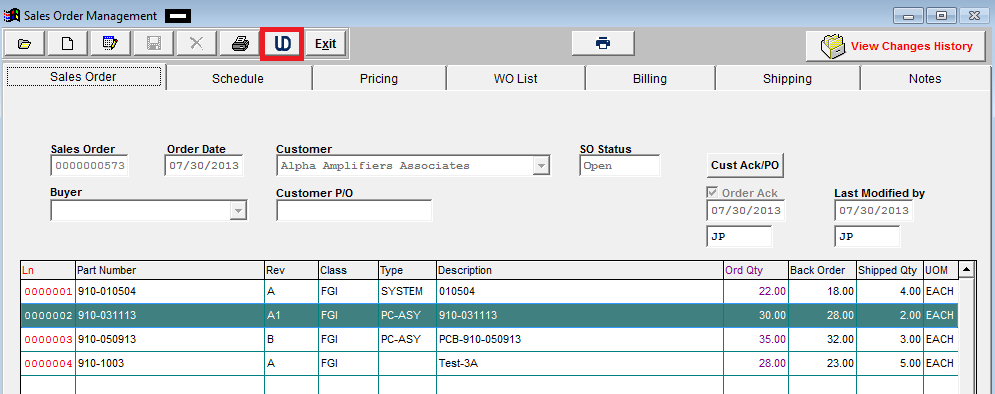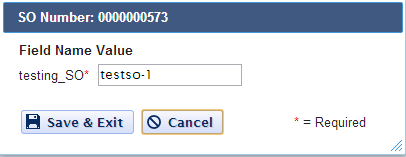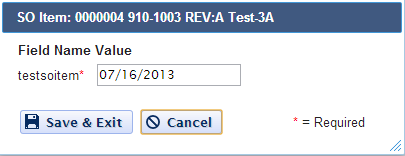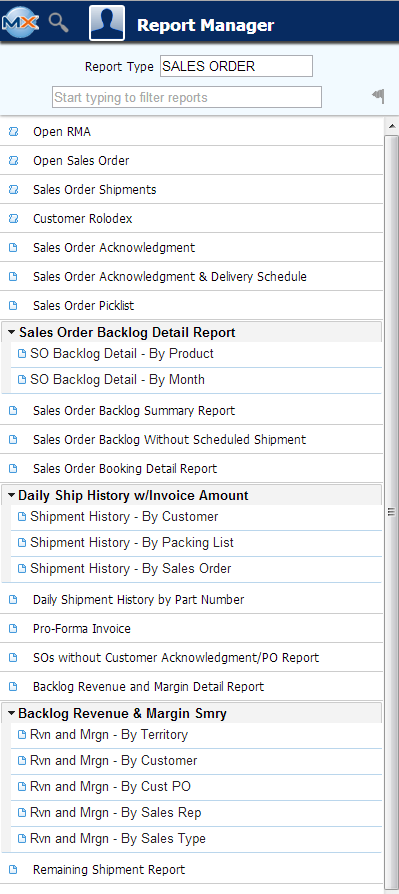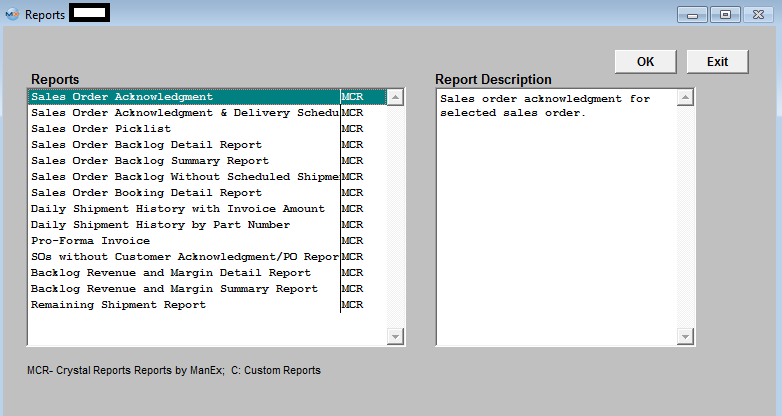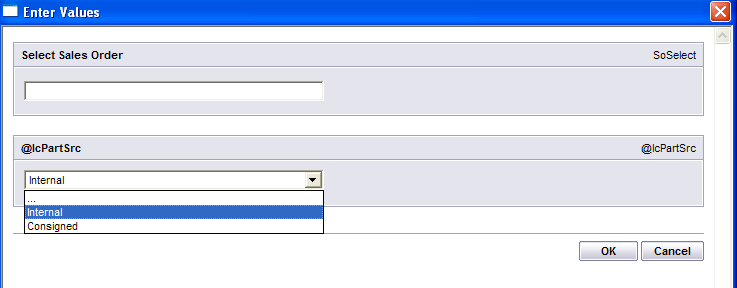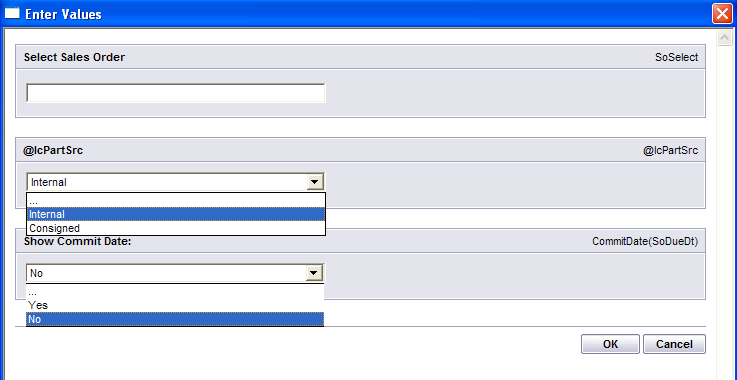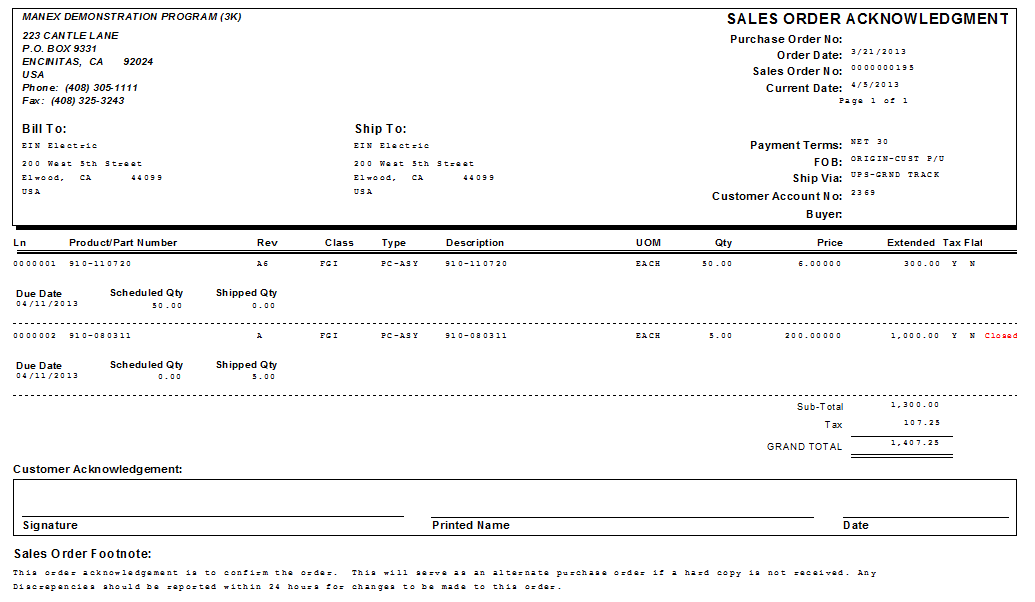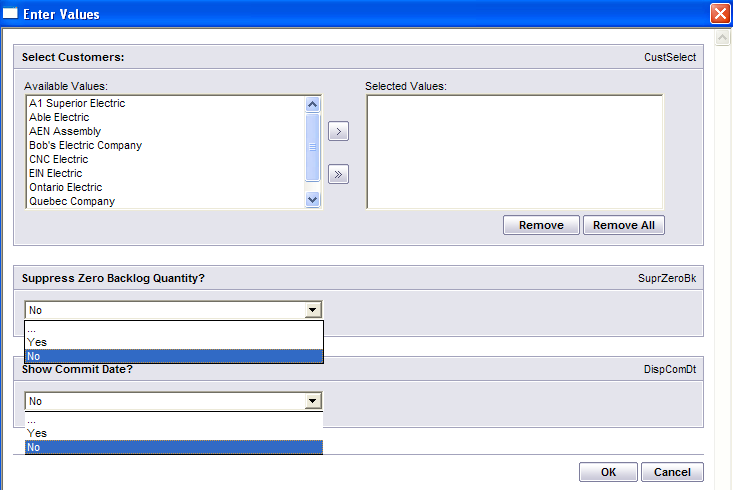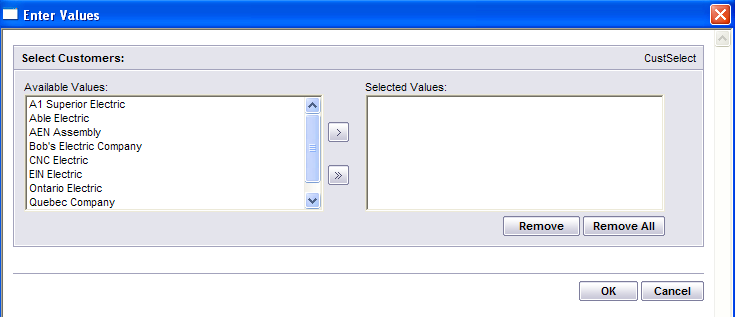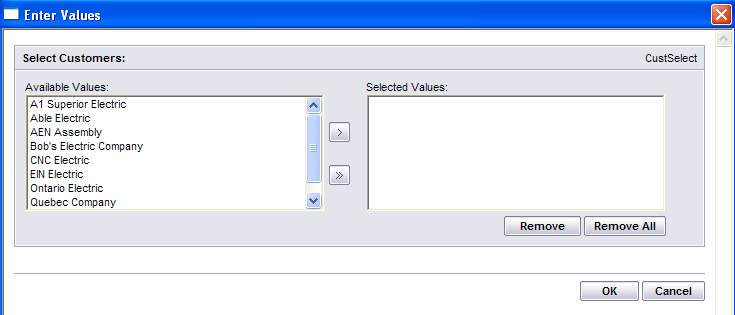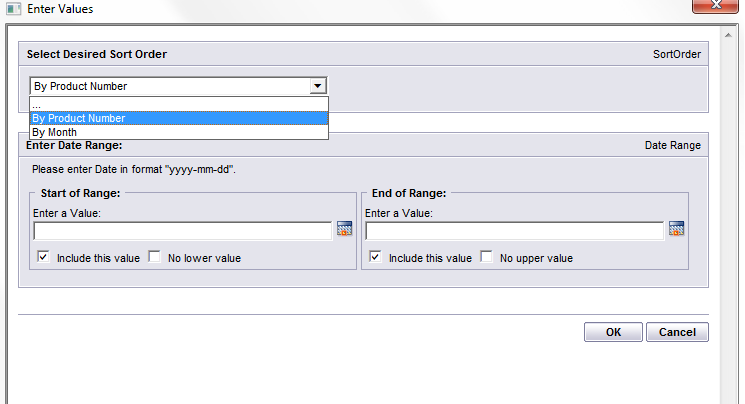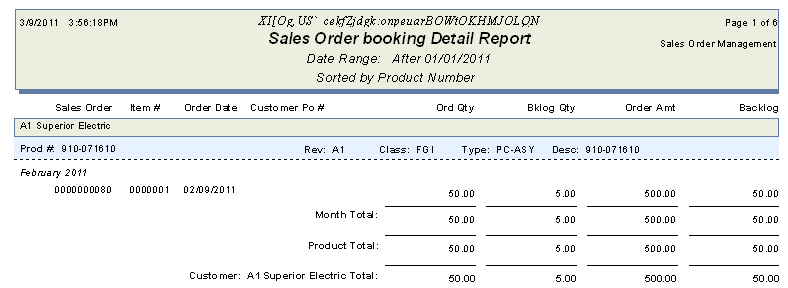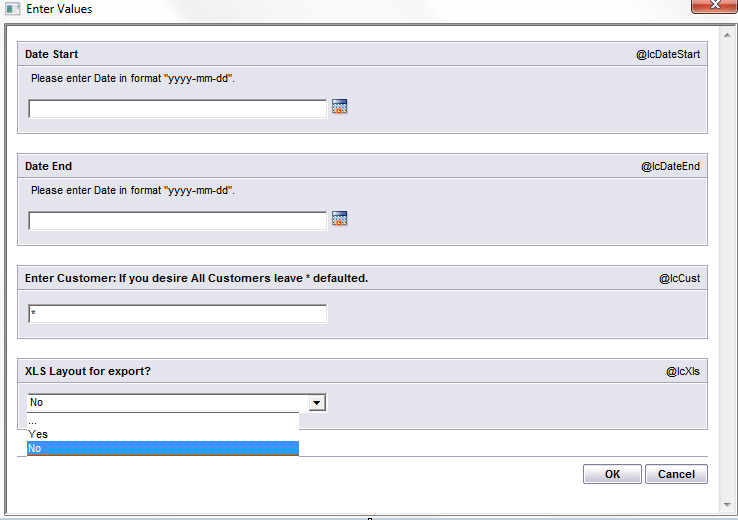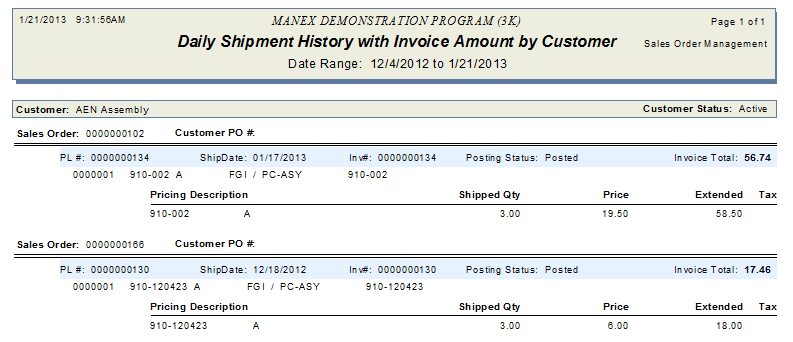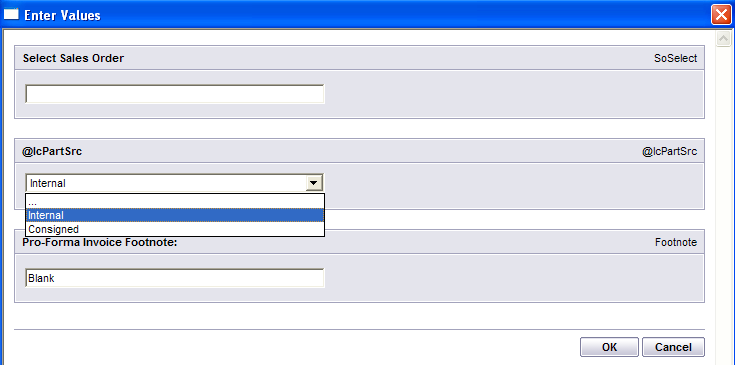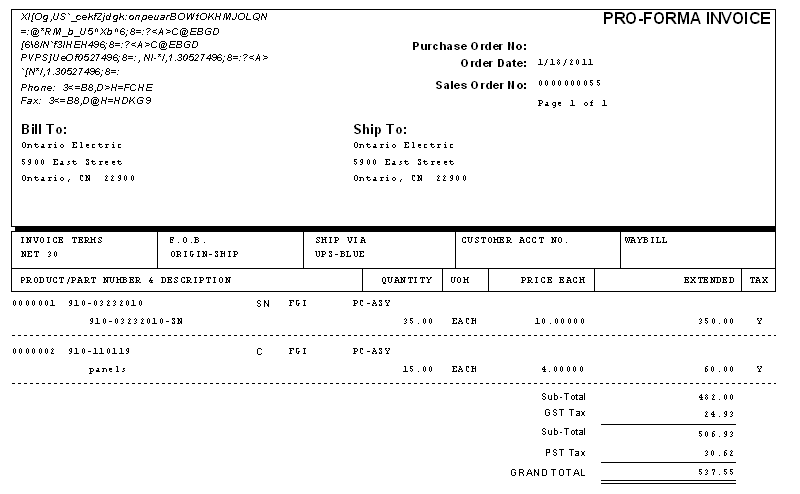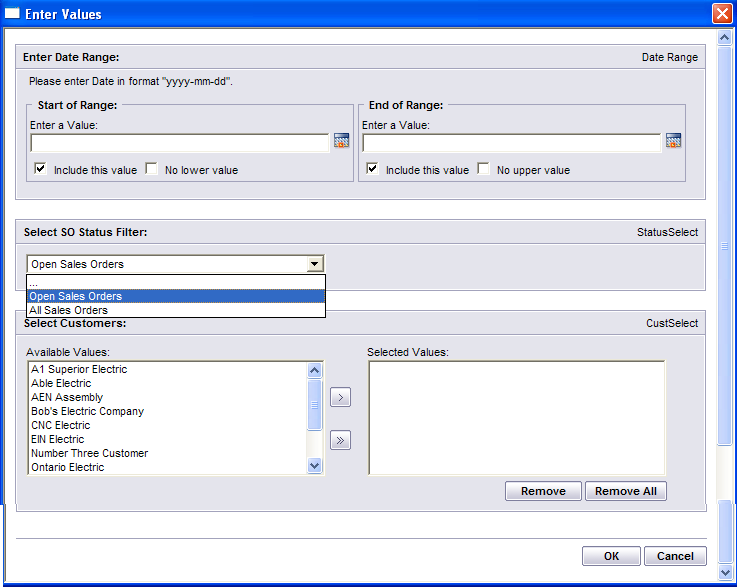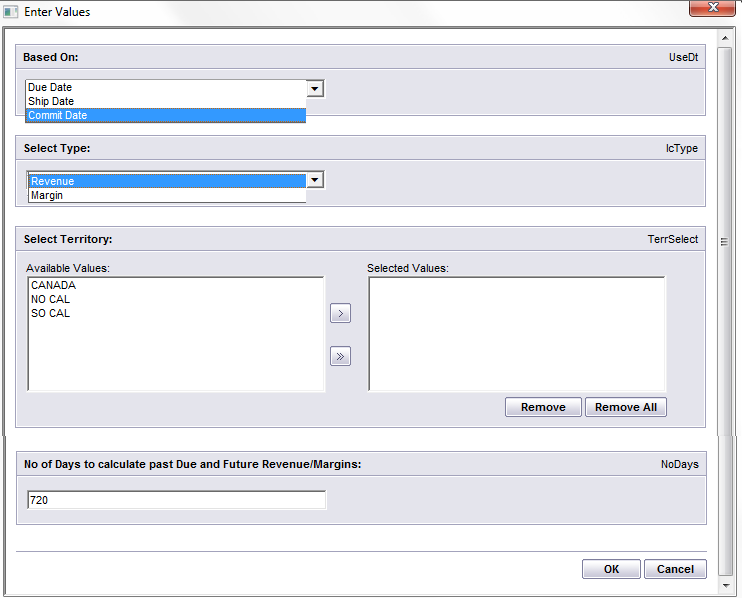| 1. Sales Order Management |
| 1.1. Prerequisites for SO Mgmt |
|
Entering the Sales Order Module There are a number of functions regarding Sales Order Entry that should be established at the initial installation of ManEx.
The following Prerequisites are required for Entering a New Sales Order:
Optional Prerequisites for Entering a New Sales Order:
|
| 1.2. Introduction for SO Mgmt |
The Sales Order Module is used to record the details of the user’s Customer Purchase Order. It is a translation of the customer’s order (or contract) to deliver goods into the user’s format and language. This is done so that the user’s various departments can refer to a common format rather than have to adjust to a variety of customers’ formats. The Sales Order should reflect exactly what the customer ordered – the part numbers, the quantities, the delivery schedules, the price, the terms and conditions of the order, and any special charges. Other important information to be included (besides the customer’s name) is the name of the contact at the customer, the purchase order number (the contract), whether or not the purchase order or contract has been agreed upon by acknowledgment of the Sales Order. The user initiates the internal flow of operations by completing the Sales Order. This order then is used to track the progress of the customer order, account for costs and revenues, determine the manufacturing performance to commitment, define the company backlog of sales, schedule workloads, and in general direct the activities and operations once the customer’s order is accepted. The Sales Order module serves several functions relating to orders:
To review and edit an order, the user FINDs the order to display it on the screen. There are a number of ways that ManEx provides for the user to aid in locating a specific order, which are discussed later. Once an order is found and displayed, the order may be EDITED to make desired changes to the order. To create a new order, the user performs the ADD function. Once in the Sales Order, the user may add or edit the products being delivered to the customer, including the quantity. The deliveries may consist of products, (assemblies made by the user), and/or parts (from the user’s inventory), and/or miscellaneous items (non-inventory items or services). The sales order program will determine pricing from the pricing module, if the part has had pricing entered. Otherwise, the user must add the pricing as the products are entered. If the Pricing module doesn’t have the part entered, the user must also select the Sales Type. The user must then establish a schedule for shipping the product. The schedule may be for a single shipment, or scheduled out over a period of time with the same or different quantities for each delivery. In ManEx, there is also the provision for automatic scheduling, which simplifies the scheduling if the user wishes to ship a fixed portion of an order each day, week or month. The user may then verify that the Bill-to and Ship-to information is correct. It will be entered automatically in the Sales Order from the Customer Information module, using the default values. If more than one address exists for the customer, the user may change this information to match the individual order, if desired. The user may also create work orders for the product FROM the sales order module. If the product is scheduled for multiple deliveries, the user may elect to make one order for all parts, or spread out the deliveries over multiple work orders. We do not allow the Work Order to be released within the Sales Order module. The Work Order module is a very valuable feature and should not be by passed. The purpose of the WO Release is for various departments to fulfill their part of the task of releasing the WO on-line to avoid doing it manually.
|
| 1.3. Fields & Definitions for SO Mgmt |
| 1.3.1. Sales Order Tab | ||||||||||||||||||||||||||||||||||||||||||||||||||||||||||||||||||||||||||||||||||||||||||||
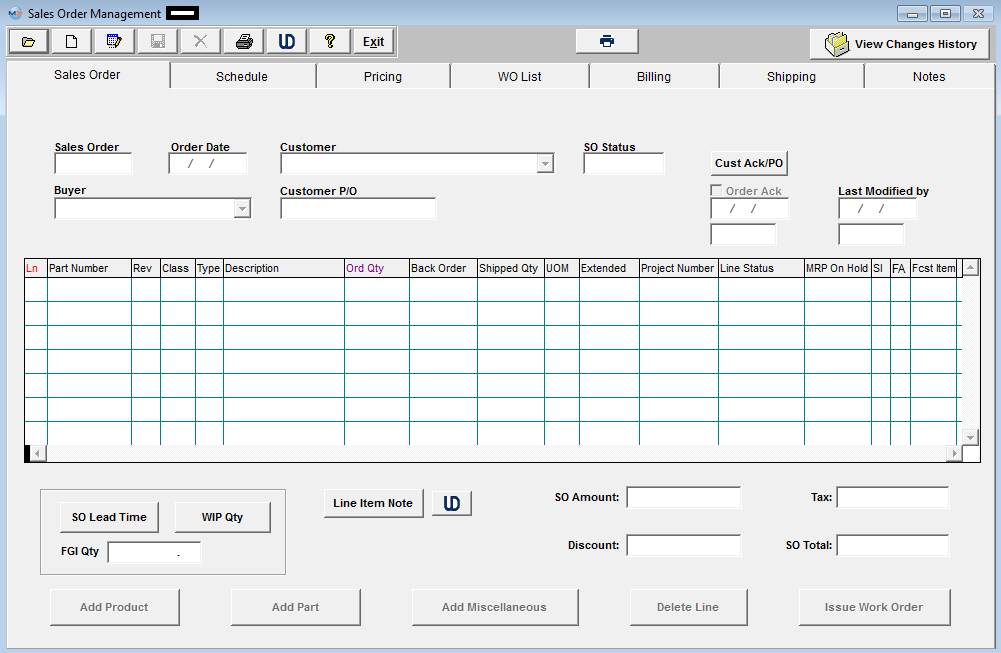 Sales Order Tab field definitions
For the line item highlighted:
Directive Buttons:
|
| 1.3.2. Schedule Tab | ||||||||||||||||||||||||||||||||||||||||||||
 Schedule Tab field definitions
Delivery Schedule Section:
Buttons:
Auto Scheduling Section:
|
| 1.3.3. Pricing Tab | ||||||||||||||||||||||||||||||||||||||||||||||||||||
Pricing Tab field definitions
Commissions Note: For this information to be displayed on the SO user MUST also have "sales commission management" rights within the Security module. NOTE: The Sales Commission information was added to the system to allow our users to create their own customer commission reports based on the information that is stored within the tables. I would suggest that you consider using Crystal Reports to design the desired Commission report that would best fit your company, using the information stored within the ManEx tables.
|
| 1.3.4. WO List Tab | ||||||||||||||||||||||||||
 WO List Tab field definitions
The name of the Customer. The Sales Order Line Item Number. The number the user has assigned to the part or product. The revision number pertaining to the part number. The classification to which the part number belongs. The type within the classification to which the part number belongs. The description of the part number. This is the number assigned to the Work Order for the assembly of the product. This is the date that the Work Order is due to be completed. This is the quantity to build by the date indicated. This is the un-shipped quantity. For the Work Order highlighted, this is the current work center location. This is the quantity of the Work Order currently in the Work Center. |
| 1.3.5. Billing Tab | ||||||||||||||||||||

The name of the Customer. The Billing address of the Customer. The Credit Status the Customer has with the user. This is the limit the user has for the Customer. The balance the Customer has in the user’s Accounts Receivable Aging. This is the sum of all other Open Sales Orders. This is the net credit available after subtracting A/R balance and the sum of the other open Sales Orders from the Credit Available. This is the total amount of this Sales Order. This is the credit available to the customer after considering this Sales Order. Note: If the user has selected to "Enforce Credit Limit at Shipment" (within the Sales - A/R Setup module) only a supervisor password can release the shipment. This section contains any notes regarding the Customer’s credit. This field is for internal use only and will NOT be displayed when printing Packing List or Invoice. |
| 1.3.6. Shipping Tab | ||||||||||||||||||
 Shipping Tab field definitions
This is the name of the customer. This is the Customer’s Ship To address. The name of the Customer’s Contact to whom the shipment will be directed. This is the point where title passes The is the name of the carrier. This is the Customer’s account number with the carrier.This would be used where the customer paid the carrier directly for the shipment. The is the time by which the shipment should be at the Customer’s address. |
| 1.3.7. Notes Tab | ||||||
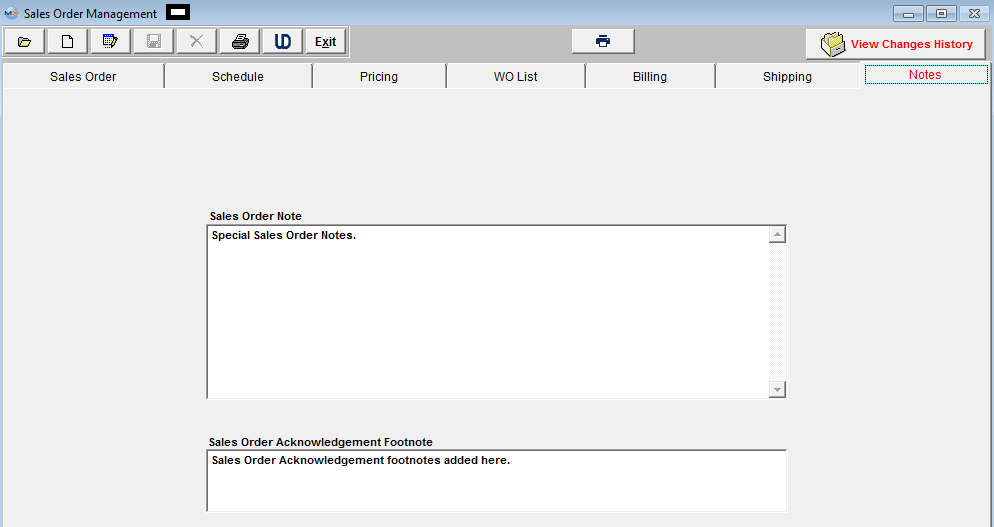 Note Tab field definitions
|
| 1.4. How To ..... for SO Mgmt |
| 1.4.1. Find A Sales Order | ||||||||
The following screen will be displayed:
If user selects ANY of the Filters and Find by All - a screen will appear listing all the Sale Orders filtered by the selection, in numerical order, along with the Customer name. Once you have made your choice, the information will be displayed as follows:
Note: When an RMA is created, both the pending receipt of the items from the customer and the subsequent shipment of replacement product to the customer is entered. Reference is made to the original Sales Order and Invoice only to allow the credit memo (when created) to have a place to apply the credit. Otherwise, there is no interface between the Sales Order and the RMA modules. If you were unable to find the Sales Order, try to locate it under the RMA menu item. See RMA Management Module Article #1610 for further assistance. |
| 1.4.2. Edit A Sales Order |
Find a Sales Order, it may be edited by selecting the Edit Action button, then entry of the password. All fields available for editing will be enabled for modification. Sales Order tab - The user may add a new product, part or miscellaneous item. The user may delete an entire line item. The user may Issue a Work Order (if one hasn't already been issued). The user may change the quantity ordered, add or change the amount reserved or change the line status. To remove a project number from the project field, ,by right clicking on the field. (Note: If a SO for example has three line items and user deletes only line item 01 user will NOT be able to re-use this line item when adding a new line item to this SO. The system will use the next line item which would be line item number 04 in this example).
Schedule tab - For the Line Item selected, the user may add or delete a scheduled delivery, change the 1st Due Date, or the Transit Days.
Pricing tab - For the Line Item selected, the user may edit the Price, Sales Type, Tax, Lot Charge, Commissions info, Add or Delete a line. The Price Markup field is NOT editable within the Sales Order screen. This information defaults in from the Sales Price List Information module. The Customer Sales Discount field is NOT editable within the Sales Order screen. This information defaults in from the Customer Information module. 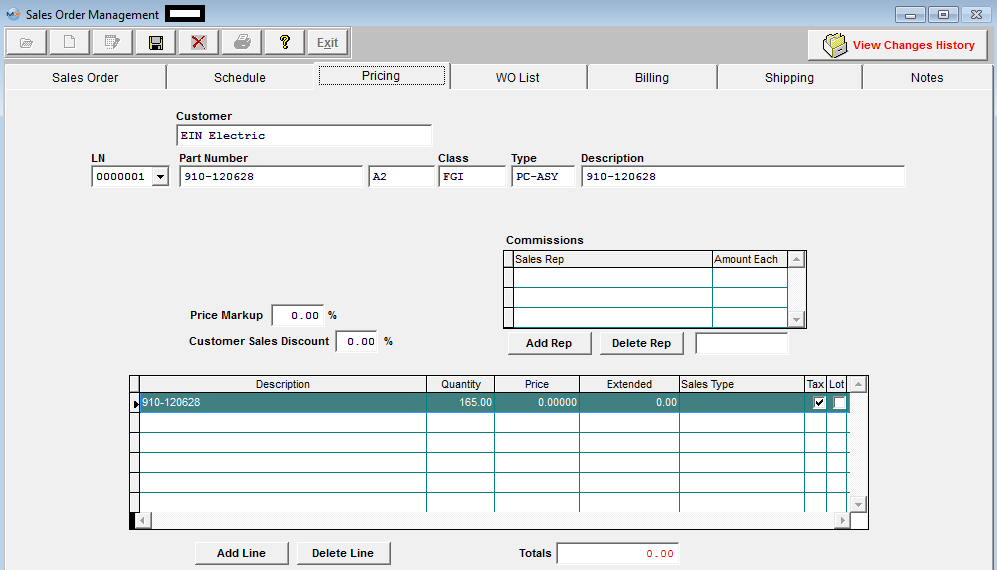 WO List - This screen is view only. 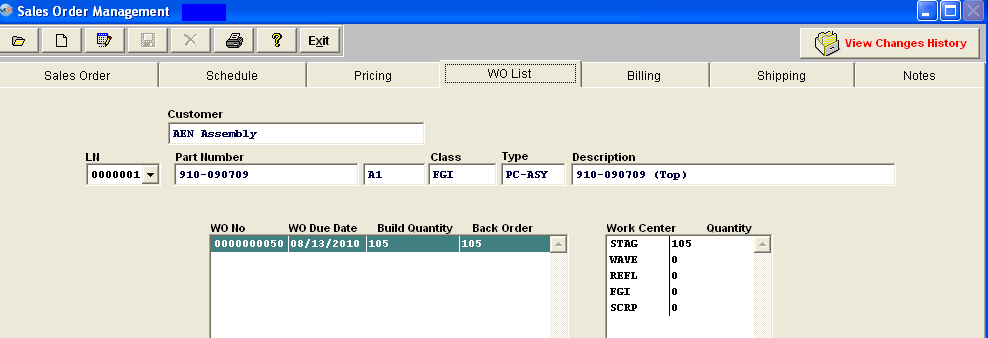 Billing tab - The user may change the Customer address and/or add a Credit Note. 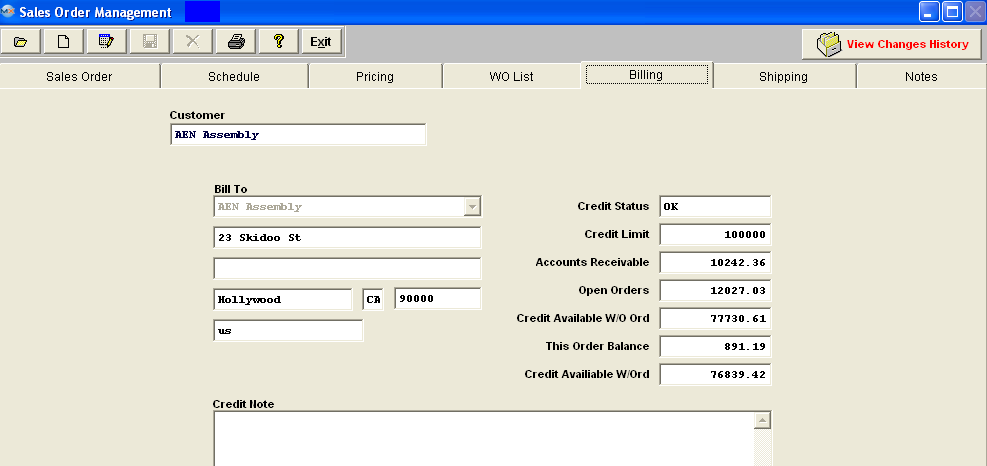 Shipping tab - The user may edit or Add a New Ship To address, select a different Attention, FOB, Ship Via, and/or select a different Delivery Time from the pull down. Note: The user is able to edit or change the Cust Account No to match any special Ship Via pertaining to the specific order within the SO Shipping screen without the changes affecting the Customer Information module or any other pre-existing orders. 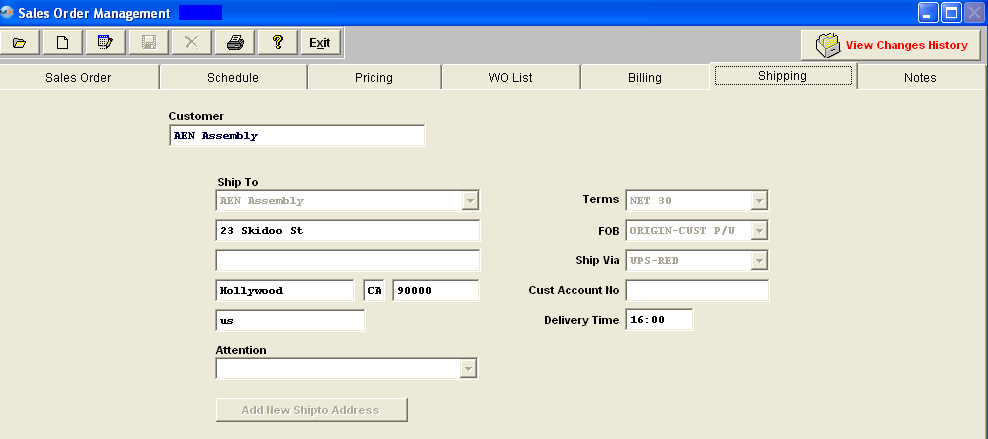 Notes tab - The user may add or change the Sales Order Note and/or the Sales Order Acknowledgement Footnote.  At the conclusion of the modification process, the user may either depress the Save action button to save the changes or depress the Abandon changes action button to cancel changes, located at the top of the screen. The following message will be displayed to the user if a WO is linked to the SO:
 NOTE: The link is for reference only between the two modules and they are still individual records so when any changes are made to either the SO or the WO the change will NOT update or be carried forward to the other. |
| 1.4.3. Add A Sales Order | |||||||||||||||||||||||||||
Adding a sales order is accomplished by first selecting the customer, a product and quantity. Then the user visits additional tab/screens to add more information about the order. The first of these is the Schedule Screen, where the user defines the delivery requirements for the product, then the Pricing Screen. The user should visit the Billing Screen and the Shipping screen to ensure that the defaults established for the customer are appropriate to the order being entered. If the user is visiting this screen to view an existing sales order, they may tab to the WO List screen and view current work orders in process. Depress the Add action button. Enter your password. And the Sales Order Screen will be displayed. The current calendar date will default in the Order Date field. This may be changed if desired.
 If the user is using auto-numbering for sales orders, the Sales Order field will be completed by ManEx when the order is saved.
The next field to enter is the CUSTOMER. The user may begin entering the name, and ManEx will immediately begin tracking the key-entry to bring up the customer with as few keystrokes as necessary to identify the customer. Or, you may press on the down arrow adjacent to the field and ManEx will display all of the customers from which to choose for the order.
The SO Status is defaulted to the OPEN status during entry of a new sales order.
Next, a customer Purchase Order number is entered. This is a free-form field, and up to twenty of any normal characters(any combination of alphabet or numbers) may be entered. If the user has a purchase order from the customer, or a confirmation of the order from the customer, then the ORDER ACK box can be checked. If this box is NOT checked, the user will NOT be able to create a packing list for the order when it comes time to ship. If this box IS checked, then the date and initials of the user accepting responsibility for the order are recorded. The next step is to use the Directive Buttons to add information into the sales order. |
|
The "Add Product" button adds products or assemblies to the order. Pressing this button brings up the following selection screen. User may enter in a Product Number, Part Class, or select ALL, which will display a list of products that have been established for the customer selected for the sales order. The user selects the product number being ordered by entering it in the red box, or scrolling down the list and double-clicking on the assembly.
Note: If the user enters specific customers in the Customer List within the Sales Price List Information module, then that product will only be available for that customer when creating a Sales Order. |
 |
After selecting a part number, ManEx requests the quantity to be ordered.

You may view additional information about the part by sliding the scroll bar at the bottom of the grid to to the right.
![]()
|
The "Add Part" button is to add a part from inventory to the sales order. This is material that is sold out of the stockroom, rather than material assembled to order. It may include any part carried in ManEx inventory, with a source as “Buy”. Pressing this button brings up the following dialogue box: User may enter in a Part Number, Part Class, or select ALL, which wiil display a list of Inventory parts. The user selects the part number being ordered by entering it in the red box, or scrolling down the list and double-clicking on the assembly. Note: If the user enters specific customers in the Customer List within the Sales Price List Information module, then that part will only be available for that customer when creating a Sales Order. |
 |
|
After selecting the part number the following dialog box will be displayed, displaying the Warehouse, Part Mfgr, Mfgr Part Number, Warehouse Location and the Quantity Available. Highlight and double click on the desired Part Manufacturer. |
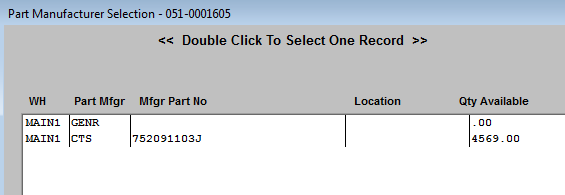 |

Note: When the user enters a quantity for a part, the system will check to see if there is a minimum and/or multiple setup in Inventory for this particular part/product.
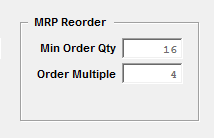
If the order quantity doesn't meet the requirements, the statements shown below will popup and display in the item master min and mult order quantity with an OK button. No other action is required. The user can choose to change the order quantity to match, or proceed as entered
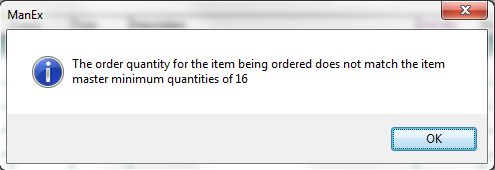
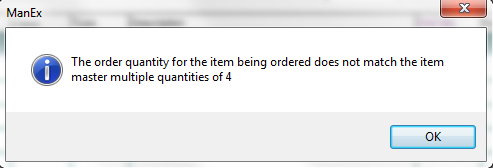
![]()
The "Add Miscellaneous" button is to add any miscellaneous items to the sales order. This may be prototype items, engineering charges, or any item that is not manufactured nor is it in inventory. Pressing this button adds a line to the Sales Order and moves the cursor to the description field. The user enters the description, quantity and may then move to the pricing screen to complete the data.
The user is reminded that the scroll bars at the right side and bottom of the information box allow the information to be scrolled sideways and up or down to see additional information.
![]()
The "Delete Line" button is to delete a line already entered from the Sales Order. The user selects the line to be deleted from the Sales Order tab, and presses the button.
|
Pressing this button brings up the following dialogue box: The user confirms the deletion and the deletion is complete. |
 |
 Highlight the Assembly line item first before you depress the button.
Highlight the Assembly line item first before you depress the button.
Important Note: This action is taken AFTER the Scheduling tab is completely filled in for all add Products (assemblies). So, first go to the Schedule tab (instructions below). Schedule the product and then return to this tab.
| If user has the "SO Approval Required" box check in Sales Order Defaults & Sales Discount Type module checked, then user will be required to check the "SO Approved" box before being able to Issue a Work Order. If the "SO Approved" box is NOT checked user will receive the message located to the right. |  |
| If line item is on Admin Hold or Mfgr Hold user will receive one of the following messages and will be unable to Auto create a WO until the status has been changed for this specific line item. User will be able to manually add a Work Order for this product in the Work Order Management module. |
|
|
If there is only one delivery scheduled for the sales order, and the work order setup is established as automatic numbering, then the following screen appears:
Keep in mind though that even if you have the SO linked to a WO does not mean that the quantities will always be the same. The link is for reference only between the two modules and they are still individual records so when any changes are made to either the SO or the WO the change will not update or be carried forward to the other. A message is displayed to the users that they will have to make the same changes to the WO. |
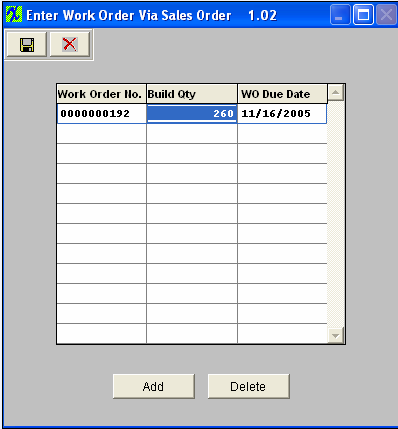 |
|
If the user has established more than one delivery date for the sales order, then pressing this button brings up the following: |
 |
Depress the Save action button to finish creating the Work Order(s).
After completing all of the Sales Order data, the Sales Order must be saved. Then pressing the WO List tab will display all of the work orders created for the current sales order.
Schedule Tab
There are two modes available for completing a scheduled delivery for a product: Automatic and Manual. In the Automatic mode, ManEx will take a beginning date and a quantity to be delivered each period (Days, Weeks or Months) and schedule out the delivery using the Delivery Schedule Default Days which are setup in the Delivery Schedule Default Setup module.
Clicking on the Schedule screen tab brings up the following:

Sales Order Line number: Select the line number by depressing the LN down arrow. The following selection will be displayed:

| Automatic Scheduling |
Pressing this button enables the scheduling box and places the default lead time date in the Due Date box. (The user may establish a default number of days setup in the Delivery Schedule Default Setup module). The user can then use that date, or enter the first (beginning delivery) date the customer expects to receive the order. The Delivery Qty screen allows the user to divide the shipment into multiple deliveries of equal parts. For example, if the order is for a total of 100 pieces, and the customer wishes delivery to be at the rate of 10 units each day, then the delivery quantity should be entered as 10. The next box allows the user to select the delivery intervals. The options are by day (DY), week (WK) (7 days) or month (MO) (30 days).
Note: In using the term Weekly and Monthly, it doesn't matter what the holidays or what the weekends are (i.e. that they are not excluded from the total time of a week or month), but are considered when the final date is calculated. |
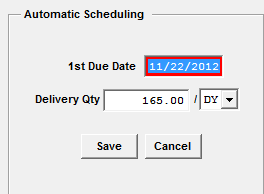 |
| Manual Scheduling |
Pressing the Add Line button enables the delivery schedule box and places the cursor in the Due Date box. The user can then enter the first (beginning delivery) date the customer expects to receive the order. Next, the Ship Date (the date the order is to leave the user’s dock) will be entered by ManEx based on the transit days entered. This date can then be modified by the user if a different date is desired. Then the scheduled quantity is entered. The Shipped quantity will be completed by ManEx when the line has material shipped against it. Additional lines may be added or deleted by pressing the appropriate button. The total number of units scheduled will be displayed at the bottom of the box, so the user can verify all units have been scheduled. |
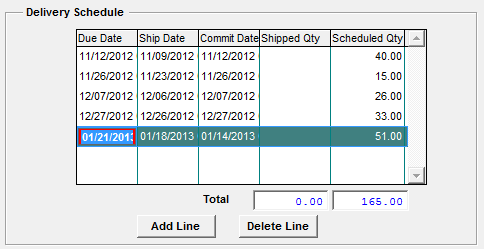 |
After you’ve scheduled all assemblies, you may go back into the Sales Order tab and issue the Work Orders for those assemblies. Please refer to the instructions above regarding the Issue Work Order button.
Pricing Tab
Clicking on the Pricing screen brings up the following screen:
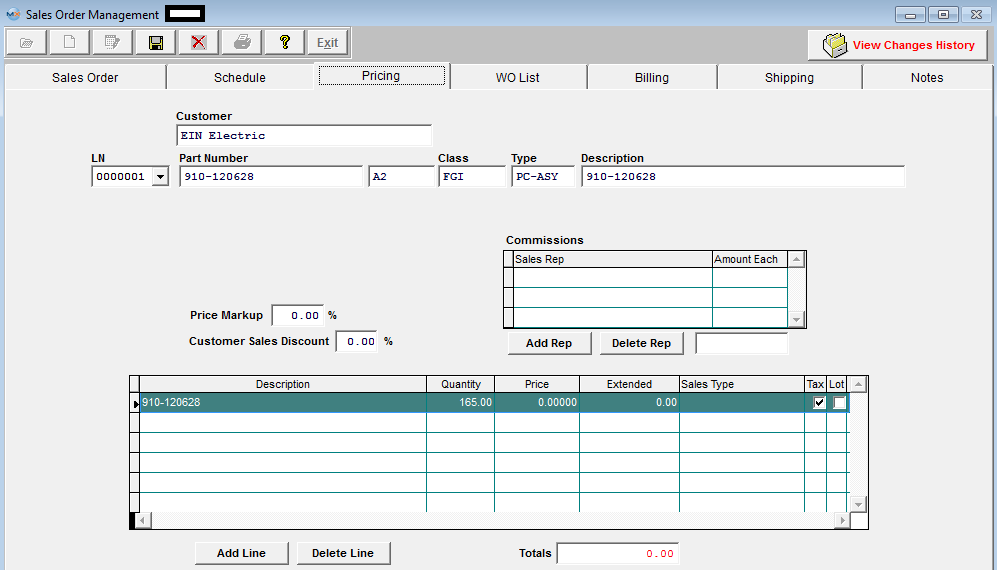
Depress the down arrow next to the LN field. The following list will appear:

Select the desired line number. If the user has completed the Pricing Screen for the product, then the pricing will be automatically entered. See Article #766 for more detail.
|
Depress the "Add Rep" button to add a Sales Rep. The following screen will appear listing all the Sales Rep's setup in the Sales Rep Information module.
Highlight the Sales Rep or Reps, then depress the OK button and they will appear in the commissions box as displayed below.
|
 |

Enter in the commission amount for that specific Sales Rep.
If accounting is installed,the user selects the Sales Type. The user can select the Sales Type from the drop down list:

If the user has completed the Pricing Screen for the product, then the pricing will be automatically entered. See Article #766 for more detail.

For Sales Order Items with no Tax, leave the Tax box unchecked. No further action is required.
Adding a US Sales Tax or a US Shipping Charge Tax in Customer Information requires that those items added be entered in System Setup under Sales Tax Authority Table.
If a particular Customer Ship To Address has more than one US Tax (such as a Sales, Use, Excise, etc. tax), then the taxes may be entered in System Setup individually and added individually to the appropriate Customer Ship To addresses.
User CANNOT manually add Foreign tax to Sales Orders or Invoices. The Foreign tax box must be checked for the Shipping Address for the particular Customer selected in the Sales Order Header.
If the Foreign tax box is checked for the Shipping Address for the particular Customer selected in the Sales Order Header. Pricing will be listed as follows on the Sales Order Acknowledgement, Invoice, RMA, and Credit Memo: First the Product Sub-tot AMT, the Sales Discount (if applicable), the Freight AMT (if applicable), a SUB-TOTAL, the GST TAX (Primary tax) (Note: the Primary tax will always be displayed even if it is zero, if a Secondary Tax is present), then a second Sub-Total, PST TAX (secondary tax), and last the TOTAL. If no PST tax (secondary Tax), Sales Discount, or Freight is involved, then no lines would print for these items. See the Foreign Tax Examples.xls attachment to see how the Primary and Secondary taxes are calculated.
The Primary tax and Secondary tax is divided into the Sales tax and Shipping tax on the Sales Tax reports.
For Example:
Primary Tax (GST): 144*10% (sales tax) + 0 (no freight tax is calculated) =$14.40
Secondary Tax (PST): 144*8% (sales tax) + 12*8% (Freight tax) = $12.48
Divided into sales tax and freight tax:
Sales Tax: 144*10% (sales tax) + 144*8% (sales tax) = $25.92
Freight Tax 0 (from primary tax) + 12*8% (from secondary tax) = $0.96
If the user wants to use a Lot Charge instead of unit pricing, click on the Lot box. This will take the unit cost as a lot charge for the item without extending the units by the price. This may be used if a flat fee is charged for a number of parts.
Clicking on the Add Line button may enter additional charges for the product. These charges may carry a different unit price, and may be of any description. A Non-inventory line added on this screen will be invoiced on the first shipment made for this sales order.
Work Order List Tab
Clicking on the Work Order List tab brings up the following:

Depress the down arrow next to the LN field. The following will display:

Select the line item containing an assembly for which Work Orders have been created.
This screen is for information only, providing the user with status of work orders created for the current sales order. The user has the option of creating multiple work orders for a sales order line item. To see the Work Orders for the next line item, depress the LN down arrow and select the desired line item.
Billing Tab
Clicking on the Billing screen tab brings up the following:

In this screen, a Bill-to address will be completed with the default address established in the Customer Information Module. The Bill-to address also may be selected from any other addresses entered in the Customer Information Module. The first prompt is to enter the Bill-to address. The user may accept the default address, or select from any address established in the Customer Information Module. All address information in the set up will be displayed when the down-arrow is pressed at the right side of the field:
After selecting the appropriate bill-to address, the information fields on the screen are populated with the correct data.
Shipping Tab
Clicking on the Shipping screen tab brings up the following:

As in the Billing screen, the user may select from established ship-to addresses by pressing on the down-arrow key at the right of the first field:
Notes Tab
The last screen, the NOTES screen, provisions are made to establish Sales Order Notes and/or Sales Order Acknowledgment Footnotes. These notes are available on their respective screens.

Note that when any note is entered on this screen, the screen tab NOTES turns red to indicate there is data in the notes.
Once all Tabs have been complete Depress the Save action button to save changes or the Abandon changes action button to abandon changes.
| 1.4.4. Cancel a Sales Order |
To cancel a Sales Order
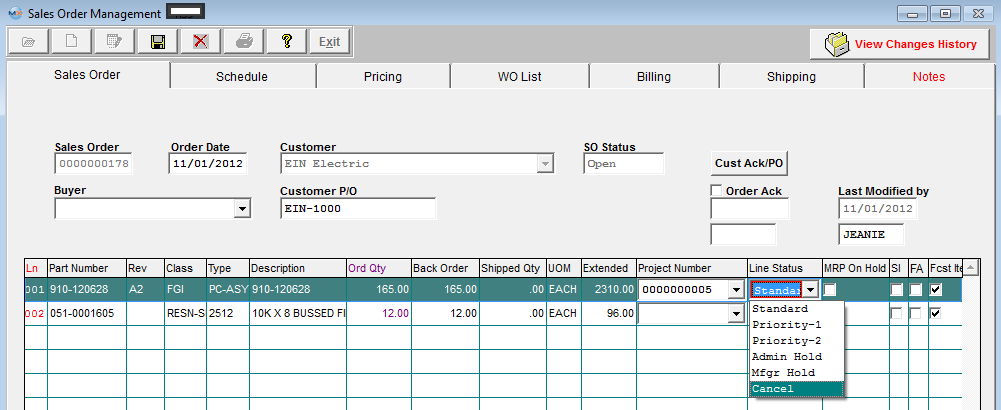 Once you have cancelled a line item on PO the following message will be displayed: 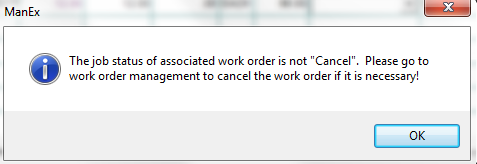 Depress Ok and the Sales Order status will be changed to "Cancel" Depress the Save action button, to save changes. Press the Red "X" to abandon changes. Depress the Exit action button to exit the current screen and returns the user to the previous screen. |
| 1.4.5. Delete a Sales order |
A sales order may be deleted using the Delete Unwanted Sales Order in the System Utility Module. This utility will allow users to delete any Sales Order record within the system as long as there are no shipments or reserved qty against it. In addition to deleting the Sales order, the utility will also check to see if there were any linked Work Orders to that Sales Order, if any were found it will display a warning and then also generate a XLS spreadsheet for the users to review and re-establish links to new Sales Orders if desired. |
| 1.4.6. Link User Defined Fields to a Sales Order |
| The User Defined fields MUST be setup within Web ManEx. For further detail see Article #5454.
The User Defined Fields can then be linked to a Sales Order or a line Item on the SO.
To link a UDF to a Sales Order select a record in the ManEx
Desktop, and select the UD action button (as displayed below).
The UDF for that section will then be displayed, and user can make changes (if applicable), Save & Exit or Cancel.
To link a UDF to a Line Item on the SO select the line item, then select the UD action button that is located in the SO body (as displayed below)
The UDF for that section will then be displayed, and user can make changes (if applicable), Save & Exit or Cancel.
|
| 1.5. Reports for SO Mgmt |
| 1.5.1. Reports for SO Mgmt | ||||||||||||||||||||||||||
To obtain the Sales Order Reports within the Web, select the WEB Print button from the ManEx action buttons at the top of the screen. For further detail on How the Reports work within the Web refer to Article #5477. Note: In order to access the Reports within the Web the Company Root URL must be setup within the System Appearance module and user must be linked to web within the System Security Module.  Select the Report Type: SALES ORDER - A List of Reports will be displayed that are available on the Web
for SALES ORDER
To obtain the Sales Order Reports within the desktop, select the Print button from the ManEx action buttons at the top of the screen.
The following reports screen will display a list of reports that are available on the ManEx Desktop:
Highlight the desired report and then depress the OK button: Sales Order Acknowledgement Report
The following report will print:
Sales Order Acknowledgement & Delivery Schedule report
The following report will print:
Sales Order Picklist report
The following report will print: This report will display the Sales order picklist for selected sales order.
Sales Order Backlog Detail report For the Sales Order Backlog Detail report, you can select to sort By Product or By Month on the bottom of the screen.
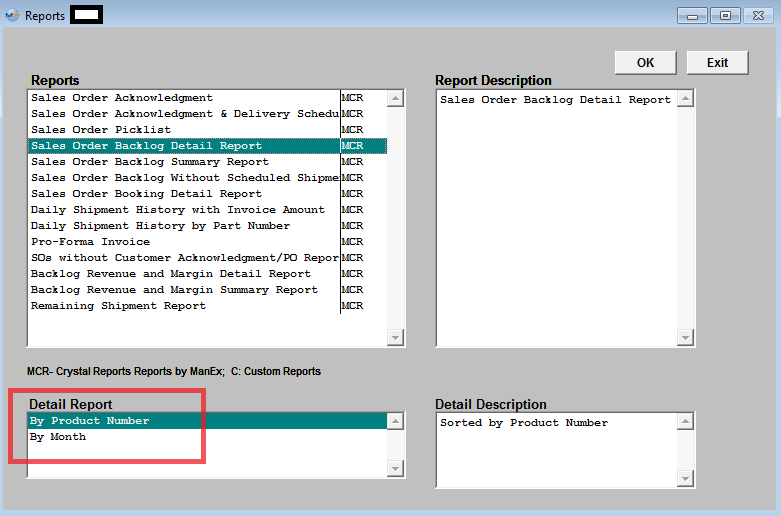
The following report will print:
 Sales Order Backlog Summary report
The following report will print:
Sales Order Backlog Without Scheduled Shipment report
The following report will print:
Sales Order Booking Detail report
The following report will print:
Daily Shipment Report With Invoice Amount For the Daily Shipment Report With Invoice Amount, you can select By Customer, By Packing List, or By Sales Order on the bottom of the screen. Depress the OK button. 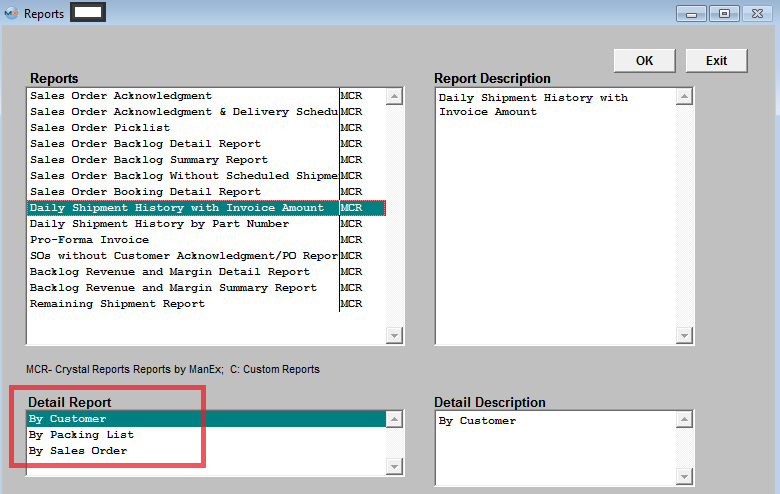
The following report will print:
Daily Shipment History Report by Part Number
The following report will print:
Pro-Forma Invoice report
SOs without Customer Acknowledgement/PO report
The following report will print: - This report will display a list of SOs that still need a Customer Acknowledgement/PO  Backlog Revenue and Margin Detail Report
The following report will print:
 Backlog Revenue and Margin Summary Report
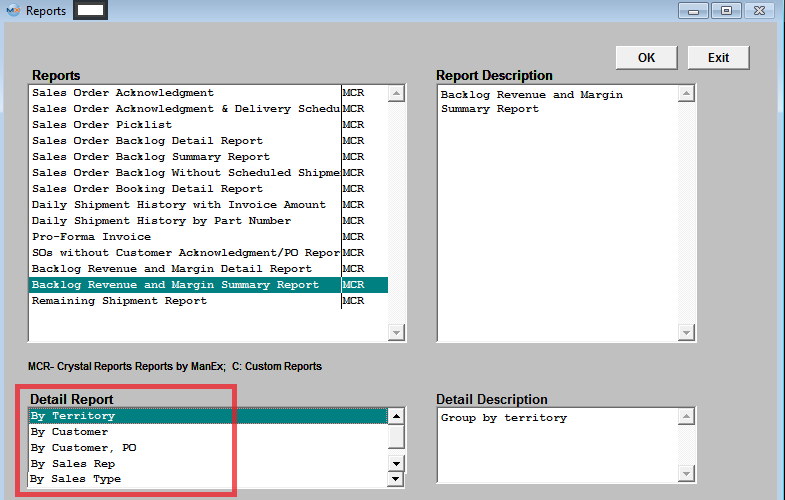 Select a Group: By Territory; By Customer; By Customer, PO; By Sales Rep; or By Sales Type
Depress OK
 Remaining Shipment Report - This report is NOT Available in SQL Yet Enter the Date to display Shipments Due Up To:
Basically, this report will get all MRP action records for SO demand that the date is up to whatever user set up on report "Option" page (default is 60 days from now). The program will get sales oder information (due date, price...) as well, then join this two set of data by sales order number and due date. That's how the proposed work orders linked to sales orders, even the user doesn't create the work orders for the sales orders. Because this report lists what order actions required in order to make the shipment, it will get those proposed WO records with negative balance, and get MRP action records for those components. If the part numbers have positive balance or regular WOs that will eventaully fill the demand, those records will be filtered out.
The following will print:
|
| 1.6. FAQs for SO Mgmt |
| Facts and Questions for the Sales Order Managment Module |
| 1.7. ManEx Minutes (SO) |

